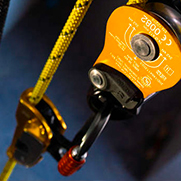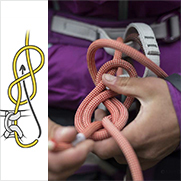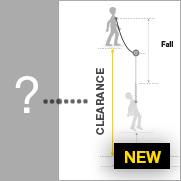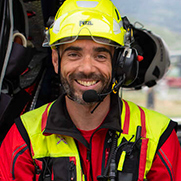Measuring the world's tallest trees
An interview with Laurent Pierron and Jérémie Thomas, founders of the non-profit association "EnQuête d'Arbres", during their last trip to Tasmania in 2016 to measure some of the world's tallest trees.
June 1 2017
Tree care
Staring straight down to the forest floor from high in the crown of the 99.6-meter tall Centurion, the world's tallest known Eucalyptus regnans tree.
Why this major project?
"At the outset the idea seemed a bit crazy, climbing and measuring the world's tallest trees. Then, after meeting Jérémie Thomas, we combined our respective expertise, know-how, and ability to get along with each other.
The number of projects increased exponentially thanks to the diversity of trees in this country and the widely ranging climatic conditions. Each expedition brings new discovery. Climbing very tall trees requires physical endurance and an enormous amount of concentration. Hiking through pristine wilderness to reach these trees brings us into contact with some of the more unpleasant local flora and fauna such as snakes, spiders, and leeches, without mentioning some of the most extreme weather conditions imaginable. There are many similarities between this type of expedition and mountaineering: self-sufficiency, remoteness, isolation, managing your gear, and traveling through the forest. The approach often takes more time than actually climbing the tree itself."
Lowering from White Knights
Does tree climbing also have its "seven summits"?
"We appreciate the symbolism of the 'seven summits' for mountaineers and hope to achieve the same thing with the world's tallest trees. No one has ever done it. This provides us with an objective, a roadmap. The big difference with regard to the mountains is that the 'seven arboreal summits' can change over time with the discovery of new giants hidden deep in the middle of a forest. The climbing aspect is also different than mountaineering. What counts for us is searching for these trees, their environment, and measuring them."
The incredibly tall White Knights
Would you like to write a guidebook on the world's tallest trees?
"No current guidebook exists, which is just fine. The fact we're climbing a living thing has influenced our decision not to publish the location of our discoveries to better preserve these trees and avoid transforming them into amusement parks. Trees are relatively fragile and we plan each of our ascents to make as little impact as possible. We never divulged the location of the tree we found in Borneo last year. We still do not know the location of Hyperion, the world's tallest tree (a sequoia more than 115 meters tall somewhere in the forests of California)."
Climbing up White Knights
This is an ambitious project led by your non-profit "EnQuête d'Arbres". What is the current status?
"We have climbed some of the world's tallest known trees as well as discovered others, such as in Borneo in 2016. Exploring trees has taken us to Australia, Malaysia, the United States, as well as all over France. Next on our list: Tanzania and the base of Kilimanjaro, Georgia, Portugal, South America, Borneo again, and then to Northern California, whose giant sequoias are considered to be the world's tallest and biggest trees. This is only a partial list and not in any particular order."
In the upper crown of Still Sorrow
Is there a link between these measurements and scientific research?
"There are specific studies on tall trees. These giants intrigue the scientific community: how is mechanically possible for vegetation to feed such a massive living thing? In France, the tallest oak trees found in Tronçais Forest measure 35 cubic meters in volume. In Tasmania, Still Sorrow, which we have actually climbed, has a trunk that measures 400 cubic meters. How do they fight gravity and successfully transport hundreds of liters of water to leaves located more than 100m above the ground? How do they react during storms? How are they adapting to climate change? These trees are the largest living beings on the planet and research regarding them is only in its infancy. They still have many secrets to reveal. Through our own personal pursuits we help to index these trees, as well as retake measurements for some, which allows observing any measurable growth over the course of a few years."
Still Sorrow, the largest known broad-leaf tree in the world, 400 cubic meters in volume
Could tell us about your network of arborists?
"The tree-climber profession represents a small group of people; we meet through events like the world championships and conferences, and our status as 'arboreal travelers' makes discussion easy within the community. The arborist profession offers an endless source of techniques to use since we work in a three-dimensional space. Whereas rope-access professionals most often work only in a vertical plane, we work throughout the entire tree canopy. This unique situation forces us to use our imaginations and we are constantly looking for solutions to different problems, like walking on a flexible branch just a few centimeters in diameter several dozen meters above the ground. Great balance alone will not work. We have to use a mix of slackline and rope technique."
Moving around among White Knights' branches
How do you identify "your" tree in the middle of the forest?
"We start by using the Internet to locate those forests known for having tall trees. Certain science research missions or forestry inventories provide information on discoveries of potential interest. Sometimes we have the tree's precise GPS coordinates, which means simply having to read a map. Sometimes locals point us to a specific area and help us in our search. Once on location, we climb the tallest tree possible, and then from the top we look for one that is even taller. We take a bearing with our compass, lower, and then head there. It is difficult changing from our European points of reference with regard to height; it is very hard to estimate a tree's height with the naked eye when in the middle of a forest, especially when the trees are more than 60 meters tall. To help us we sometimes use a laser measuring tool when on the ground for a more precise idea of height and determine if it is worth climbing the tree we discovered."
Along the trunk of Rulha Longastyle
What type of measurements do you take? Height? Branch length? Trunk diameter?
"We are happy with simply measuring a tree's height, since precisely measuring the trunks of these giant trees often requires several hours of work. With the exception of Europe, where trees are of a more manageable size, we measure height, the diameter 1.30m above the ground, and the midpoint diameter to be able to estimate the trunk's overall volume."
How do you measure tree height?
"The setup to find the tree's high and low points is rather complicated. One measurement can take several hours, and we often take it twice. The base of the tree is the midpoint between the lowest tree/ground point and the highest tree/ground point. These trees have colossal base diameters and are often located on a mountainside, which makes taking measurements a tedious undertaking. Measuring the high point is much simpler, but requires keen observational skills to identify the highest branch. The climbing is often tricky at this point, working your way up through so many branches within the crown. Once the high and low points determined, we take a precise measurement using a tape measure, which must be dead vertical or have its angle adjusted. Surprisingly, there is a very detailed Wikipedia article on the subject."
Taking measurements
How do you access a tree's highpoint?
"We have several options for starting an ascent: line launching by hand, line launching with the help of a SlingLine (a catapult), or using a crossbow. The tree structure and its surrounding environment determine the technique to use. In any case, setting up lines can take a lot of time. For example, climbing Centurion (the tallest broad-leaf tree in the world) took us four hours to climb 100 meters.
The crossbow allows us to install a rope 80 meters high, but this does necessarily equate to a quick setup. Setting lines using a crossbow goes as follows: a Dyneema© fishing line is attached to the crossbow stick, and once set up is replaced with larger diameter Dyneema© tech cord, which allows us to hoist our access rope. Next, we ascend the access rope using Single Rope Technique (SRT). Once we reach the crown, each climber uses double ropes to move around within the tree canopy."
Crossbow vs. launching by hand
And once up top?
"Measuring the high point of the tree requires climbing and positioning ourselves on very small-diameter branches, often less than 5cm, to climb as close to the top as possible. This requires taking certain precautions. Experience and intimate knowledge of different types of wood allow us to apply the right techniques. Once again, there are similarities with mountaineering and ice climbing.
We place points of protection at regular intervals along the vertical axis to utilize wood's ability to compress. Just as with ice climbing, we need to properly position each piece of protection to minimize the risk of failure in the event of a fall. We also need to carefully pay attention to where we apply weight, evaluating the tree's sturdiness with each step. We properly position our hands and feet when climbing to apply just the right pressure and limit the risk of breaking a branch. After that, moving around the tree always involves a rope anchored from above. To mitigate this rather unusual position, we install a lower anchor on a bigger, sturdier section of the tree, and climb by either self-belaying or on lead while belayed by a second. At the top we secure ourselves with a lanyard. A fall during this final step could have serious consequences since it would mean falling onto the branches located directly below the climber."
Near the top of Rulha Longastyle
Do these unique climbs help to improve your technique?
"When climbing such tall trees, we clearly step out of our comfort zone and are pushed to use our gear to its maximum capacity. We need to be capable of applying a wide range of rope techniques with as little gear as possible and establish the best climbing approach possible. Also, in areas where we lack true expertise, like crossbow technique, each expedition teaches us just a little bit more and allows us to become that much more proficient."
Climbing Still Sorrow
What gear do you use on your expeditions?
"We use tree care equipment specific to our projects (SEQUOIA harnesses, ZIGZAG, ZILLON, different types of anchors, slings, and obviously carabiners) either when climbing for ourselves or for work. We also use headlamps when sleeping in a tree. Several sports-specific products are compatible. Our choice is based entirely on weight and bulk, so for a helmet we prefer the METEOR for expeditions rather than the popular ALVEO VENT so often used by arborists for tree care. Recent developments such as lighter versions of the BASIC, CROLL, and PANTIN have made exploration much easier. The PIRANA descender is also useful due to its low weight and ability to adapt to different diameter ropes."
Still Sorrow at night...
Is this type of exploration also a human adventure?
"This type of exploration is above all else a human adventure, spending time with friends. Beyond our complementary skill sets, we work well together as a team. This is a strong point for our expeditions and allows us to overcome any surprises and unforeseen difficulties. We are lucky to have met and created "EnQuête d'Arbres". From the moment we're having coffee together at the airport to being completely lost in the forest during a downpour; we stay lighthearted, involved, and equally motivated.
Depending on the location of the expedition, we meet with local tree climbers. They help us, provide practical information, and sometimes even offer extra necessary gear. In certain countries like Cameroon or Malaysia, the arborist profession doesn't even exist, but locals who know the forest well can help point out certain exceptionally tall or big trees. Sometimes, however, we still have to handle everything all on our own."
From left to right: Jérémie Lemaitre, Jérémie Thomas, and Laurent Pierron
In a few words, tell us about your non-profit "EnQuête d'Arbres".
"EnQuête d'Arbres" EnQuête d'Arbres" is a non-profit association created by Laurent Pierron and Jérémie Thomas, two guys passionate about trees and who love to climb. Dozens of tree climbers, including the world's best, from several countries are part of the association. The initial idea was to climb the world's tallest trees: shorea trees in Asia, kisipo trees in Africa, giant sequoias in California, pine trees in Europe, eucalyptus trees in Australia, to name a few.
Slowly but surely scientific, botanical, and entomological researchers (among others) have joined our expeditions. "EnQuête d'Arbres" works with researchers on projects where they need to conduct research in the tropical forest canopy and we also provide training for these scientists."
Watch the video of the expedition on Enquête d'Arbres' website >
Included in this article
Related News








